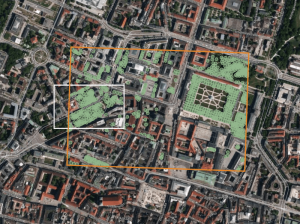Smarter Decision Making from Space
- European Space Imaging
Very High Resolution satellite imagery has become an invaluable resource for many government functions, writes Adrian Zevenbergen, European Space Imaging.
Satellites view the Earth as a whole – collecting data without regard to political boundaries. In an ever-changing and uncertain world, Very High Resolution (VHR) satellite imagery is fast becoming a common tool to predict future threats, monitor development outcomes and minimise risk at all levels of government. As such, policy makers now need to be provided with more information than ever before and usually this information is time critical.
Information derived from optical satellite imagery provides a whole new way of looking at the world. As well as tabled data, VHR imagery can provide a 3D overview of the state of the Earth and allows you to see the current situation in near-real-time, permitting optimised responses for the best possible outcome. It adds another level of detail that can serve numerous purposes and is an indispensable source of information gap filling.
Security Surveillance for Safer Borders
The power of VHR data lies in the detail. It can provide empirical answers to questions concerning multiple humanitarian and border security applications. Due to the resolution of the imagery, tents and cars can easily be identified from the sky allowing the movement of refugees to be monitored in addition to the mapping of displaced populations. The technology also provides more measured border security controls both at a domestic and international level. Oceans are large and ships are small however through the aid of satellite technology, policy makers knowledge of the entire ocean and not just coastal zones, can be significantly increased. The wide reach of the technology also means that no area of the ocean is unable to be captured. As a result, countries can reduce the number of illegal immigrants entering, reduce the death toll of human lives at seas and increase internal security within the country by preventing cross-border crime.
Agricultural Insights for Modern Frameworks
VHR imagery provides the opportunity for multispectral analysis to be conducted. With this imagery, it is possible to extract additional information that the human eye fails to see. Insights regarding crop identification, monitoring crop health, analysing soil conditions and providing smarter irrigation and fertilisation solutions can be derived. Too often, the issue regarding the lack of basic information required for sustainable food security poses a threat to governments. Without up to date information on the types of crops, planting dates, soil conditions as well as water resources, it can be difficult for governments to make smart decisions regarding agriculture policy and planning.
Urban Planning for Smart Cities
Supporting sustainable growth taking into account the capacity of local infrastructure, any environmental barriers and without exceeding budget limits poses a major challenge to government. It is estimated that in less than 40 years, 70% of the world’s population will reside in cities and therefore policy makers need to be implementing smart solutions now in order to avoid future chaos. Such solutions can be beneficially enhanced with use of remote sensing applications. When combined with GIS software, satellite imagery plays a crucial role in applications such as land and materials classification, traffic flow management, smart utilities and energy efficiency, waste management and human population mapping. In addition, satellite data is fast and reliable and can be used to monitor the change of the city and predicting its growth.
A Digital World
Furthermore, satellite imagery is collected digitally which allows for fast delivery and unlike aerial imagery, there is no data loss during the scanning process. The data takes into account real time weather assessments to maximise the success of the collection and covers a larger ground area than possible with aerial imagery or drones. Additionally it offers logistical simplicity by cutting out the need for permits, air traffic control, equipment, pilots or personnel on the ground. This is especially important when the area of interest is in a crisis or conflict zone or the information is time sensitive.
About European Space Imaging
European Space Imaging is the leading supplier of very high resolution satellite imagery and derived services to customers in Europe, North Africa and the CIS countries. Established in 2002 and based in Munich, Germany, they have been reliably supplying imagery and supporting EU earth observation programmes controlled by the EU Commission, European Space Agency (ESA), European Border and Coast Guard Agency (FRONTEX), Joint Research Centre (JRC), European Maritime Safety Agency (EMSA) and others for more than 15 years.
This article was originally published on January 21, 2019 in issue 487 of The Parliament magazine.
Related Stories

AI Uses 15 cm Satellite Images to Cut Costs and Increase Scalability in Forest Management and Urban Forestry
Forest managers across Europe face an impossible task: monitor millions of hectares with shrinking budgets while meeting increasingly strict EU environmental targets. But with the rise of AI and satellite technology, they now have new solutions at their disposal – smarter, cheaper, and more scalable – to monitor forest health, automate tree inventories, and plan sustainable logging. In this article, we introduce one of these solutions: an AI forestry algorithm developed by Arboair using 15 cm satellite data from EUSI.

GEOSeries: Extracting Insights From High Resolution SAR Imagery for Time-Sensitive Analysis
In this webinar, industry experts and advanced users of Umbra SAR data showcase how they transform SAR imagery into actionable insights in real-world mapping, monitoring and intelligence applications. See how NV5 and Umbra leverage ENVI SAR Essentials for advanced processing with time-efficient results, converting analytics into valuable intelligence.

Using Satellite Imagery to Build Water Resilience Across Europe
Water across Europe is facing severe pressure. Climate change, urbanisation, agricultural demands and other sources of pollution are threatening water security and creating critical challenges that need to be addressed. We have to act quickly, build stronger systems and create sustainable water resilience practices – so that both natural ecosystems and human communities can thrive. Here is how satellite imagery from EUSI can help.

EUSI and Albedo Partner to Deliver 10 cm Resolution Satellite Imagery to Europe
It is our pleasure to announce the partnership with Albedo, a builder of high-performance spacecraft and the first satellite designed to operate commercially in VLEO (Very Low Earth Orbit). This partnership will bring the world’s highest resolution satellite imagery to the European and North African market.





